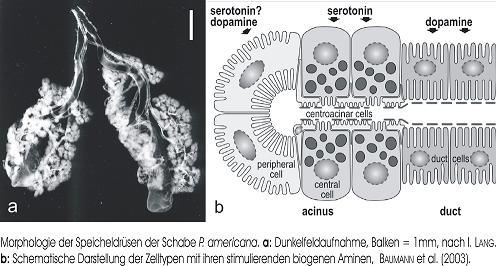| Theme |
A well-established model system for studying the cellular responses of biogenic amines are the salivary glands of various insect species, because of their good accessibility for common cellphysiological techniques.
Cockroaches (Periplaneta americana) have innervated acinar salivary glands. Within the acini the peripheral cells (P-cells) are responsible for electrolyte and water transport and the central cells (C-cells) are specialised for protein synthesis and secretion. The P- and C-cells are stimulated by the biogenic amines dopamine and/or serotonin. Stimulation of isolated glands with dopamine produces a NaCl-rich, protein-free saliva, whereas saliva secreted upon serotonin stimulation contains proteins. A salivary duct system downstream of the acini that is also stimulated by dopamine is thought to modify the primary saliva.
The processes of salivation are distributed to different celltypes. So, there is the possibility to investigate the processes of salivation separately, particulary the transport mechanisms and cellular signal pathways.

Main aims:
(1) Are the duct cells capable for fluid secretion or reabsorption to regulate the osmolality and/or the volume of the final saliva?
(2) Which role does the V-H+-ATPase in the apical membrane of duct cells play in the modification of the primary saliva?
(3) How does the biogenic amine dopamine effect the stimulation-secretion-coupling?
|
Methoden
|
Investigation of transepithelial fluid movements in isolated ducts of the salivary glands using:
- differential interference contrast (DIC)-microscopy
- fluorescent dyes (e.g. sulforhodamine) as volume marker combined with fluorescence microscopy (standard
inverse light microscope or a confocal microscope (CLSM))
Investigation of the V-H+-ATPase activity in isolated ducts of the salivary glands using:
- pH-sensitive fluorescent dyes (e.g. HAF, BCECF) combined with fluorescence microscopy
(digital pH-imaging)
- pH-sensitive microelectrodes for quantification of luminal and intracellular pH-changes
|
| Literature |
Just, F. & Walz, B. (1996). The effects of serotonin and dopamine on salivary secretion by isolated cockroach
salivary glands. J. Exp. Biol.199, 407-413.
Lang, I. & Walz, B. (1999). Dopamine stimulates salivary duct cells in the cockroach Periplaneta americana. J.
Exp. Biol.202, 729-738.
Lang, I. & Walz, B. (2001). Dopamine-induced epithelial K+ and Na+ movements in the salivary ducts of
Periplaneta americana. J. Ins. Physiol. 47, 465-474.
Rietdorf, K., Lang, I. & Walz, B. (2003). Saliva secretion and ionic composition of saliva in the cockroach
Periplaneta americana after serotonin and dopamine stimulation, and effects of ouabain and bumetanide. J.Ins. Physiol.49, 205-215.
|